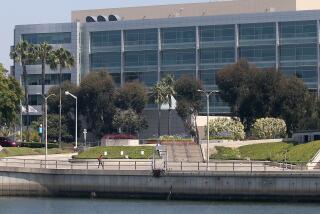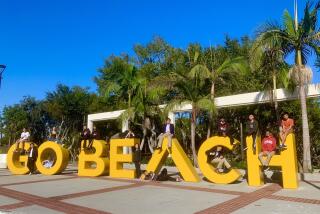Governor Will Be on Campus to Make Cal State San Marcos Official
- Share via
It may seem a little after-the-fact given the faculty hirings and land clearing already under way, but on Friday Gov. George Deukmejian will officially create California State University, San Marcos.
The governor will come to San Marcos to sign the legislation, authored by state Sen. Bill Craven (R-Carlsbad) and approved by state lawmakers last Thursday, formally naming the campus and placing it in the State Education Code that lists the 19 other state universities.
The signing is the last bureaucratic hoop to jump through in the creation of the campus, which will accept its first students in 12 months in temporary classrooms before its permanent campus opens in the fall of 1992.
Previously, the state had authorized $10.4 million to buy the 300-acre site and $47.8 million for the first phase of construction. Adding the name of the campus on the state’s rolls of higher education is the last formality, but one which still brought cheers from local boosters--not the least being Craven, who has shepherded the legislation creating the campus.
Aura of Legitimacy
“This will give it the aura of prime legitimacy,” Craven said of Deukmejian’s visit to sign his bill. “This is indeed a historical event in the development of North County. It is the culmination of a dream the people of North County have shared and strived for, for over 20 years, and the first public university built in California in 25 years.”
Once legislators decided that the new campus should be built, the most controversial issue was whether it should immediately become an independent campus, or operate until 1995 under the wing of San Diego State University, whose North County satellite center demonstrated the need for upper-division university offerings in North County and which served as the genesis for the new university campus.
CSU trustees decided the new campus should embark on its own from the get-go, with its own president and core faculty to define the new university’s academic mission.
Deukmejian’s signature will settle perhaps the last debate about the new university: its formal name. Some North County civic leaders suggested the new campus be known as San Marcos State University so the campus can better be linked to its host community and because the name would mirror, in style, the name of its sister institution, San Diego State University.
But 1972 legislation ordered that all of the campuses in the system be identified by the title California State University, followed by the place name of its location--a style also used by the University of California system. Officials argued that the consistent title for all its campuses would better link them and identify them as members of the single university system, the largest in the nation.
But to that rule came seven exceptions--campuses that historically had been known by more traditional names and won special legislation allowing them to revert to forms of their earlier names. They include San Diego State University, San Francisco State University, San Jose State University, Humboldt State University and Sonoma State University, as well as California Polytechnic State University at San Luis Obispo and its offshoot campus, California State Polytechnic University at Pomona. Both of those universities started as technical trade schools specializing in agriculture and industry.
Craven said he would have preferred naming the newest campus San Marcos State University so its name would be parallel with that of San Diego State University. He said he deferred to CSU officials, but is willing to sponsor legislation to change the name, if public sentiment suggests it.
Bill Stacy, president of the university, said he prefers the current name for the campus. “It brings instant credibility to our campus, both nationally and worldwide,” he said. “Folks have a great deal of respect for the California State University, and we’ll be able to tie in to that immediately.”
Besides, he noted, “We don’t want to confuse our university with one that might be in San Marcos, Tex.”
The university expects to enroll about 500 juniors and graduate students in the fall of 1990. Enrollment the following year will be open to juniors and seniors as well as graduates working toward master’s degrees.
Freshmen and sophomores will be enrolled in the fall of 1995.
More to Read
Sign up for Essential California
The most important California stories and recommendations in your inbox every morning.
You may occasionally receive promotional content from the Los Angeles Times.










